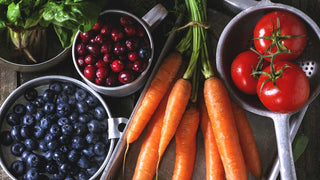We’re celebrating National Healthy Aging Month with a highlight of the best anti-aging tips for younger looking skin.
By now you’ve probably heard us talk about the importance of foods to fight aging, but you may be wondering: does it really work? The answer is a resounding, YES! It just makes sense that if you put good things into your body, you’ll get good things out of it.
Consider your skin cells as bricks in a wall; it’s possible to build a wall with whatever is at hand and cross your fingers it will weather the storm. But if you use the best quality bricks and sound mortar, you’ll have a strong, smooth and solid wall that will stand the test of time. The same holds true for your skin.
When it comes to anti-aging nutrition, choose foods that will address the top causes of skin aging: sun damage, loss of collagen & elastin, and dryness.
Prevent Sun Damage
Damage from exposure to harmful UV rays is the #1 cause of skin aging. UV light generates a tremendous amount of free-radicals, unstable oxygen molecules that wreck havoc with your skin. While the damage may not be immediately visible, sun exposure over the long-term contributes to skin dullness, age spots, fine lines and wrinkles.
Applying topical antioxidants like vitamin C, vitamin E and ferulic acid help to neutralize free-radicals. But, you can also protect your skin from within by eating brightly colored fruits and vegetables concentrated in phytonutrients – chemicals that give produce its color and guards against UV damage.
Eating a wide variety of fruits and veggies not only boosts your skin’s UV resistance and generates a youthful, healthy glow, but feeds your skin with vitamin A and increases microcirculation to positively affect skin structure.
Target foods in these three color groups that are high in the phytonutrients beta-carotene, lycopene, lutein and zeaxanthin for maximum skin protection:
- Orange for beta-carotene: Pumpkin, Sweet Potato, Carrots, Cantaloupe, Apricots, Peaches, Butternut Squash
- Red for lycopene: Red Bell Peppers, Mango, Tomatoes, Watermelon, Papaya, Pink Grapefruit, Chili Peppers, Red Grapes, Cherries
- Dark green & yellow for lutein & zeaxanthin: Kale, Spinach, Swiss Chard, Turnip Greens, Dandelion Greens, Brussels Sprouts, Broccoli, Lettuce (radicchio, arugula, romaine, green leaf, red leaf), Squash (summer or winter), Corn
Boost Collagen & Elastin Production
With aging comes a decrease in the production of collagen and elastin, the two fundamental proteins that keep skin smooth and firm. The result is an uneven, wrinkled, deflated and saggy appearance. A great way to improve collagen is with our Collagen Peptides.
Topical agents like peptides drive active compounds into the top layers of the skin to boost collagen and elastin production. And, treatments like fractional light therapy (Fraxel) boost collagen production by making tiny “wounds” to the dermis.
The good news is you can increase collagen and elastin by feeding your skin from the inside-out with the nutrients necessary for their production. The two C’s, vitamin C and copper, along with high-quality protein, are essential to building collagen and elastin to get back that smoothness, spring and bounce characteristic of younger-looking skin.
Foods rich in vitamin C, copper and high-quality protein include:
- Vitamin C: Red Bell Peppers, Guava, Kiwifruit, Berries, Citrus fruits, Green vegetables (parsley, broccoli, Brussels sprouts, kale, spinach), cauliflower
- Copper: Liver, oysters and shellfish, dark chocolate (our favorite!), Whole Grains, Nuts & Seeds, Mushrooms, Beans & Sprouts, Dark Leafy Greens (kale, spinach, collard greens), Asparagus, Eggplant, Fennel, Beets
- High-quality protein: Non-fat, Plain Greek Yogurt, Fish & Skinless Poultry (grilled, baked or broiled), Legumes (chickpeas, lentils, kidney beans, pinto beans, black-eyed peas, split peas), Tofu, Whey Protein
Hydrate & Moisturize
The final hallmark of aging is dry skin. Increased dryness, like loss of collagen and elastin, is a natural part of aging that takes its toll primarily on your skin, the body’s largest organ. While genetics and hormones account for your skin’s natural oil production, just how dry your skin gets due to aging depends on other dietary and lifestyle factors.
Too much alcohol makes skin look puffy, while an excess of caffeine increases natural dryness. Most people also go through life chronically dehydrated, further drying out the skin and contributing to the formation of wrinkles.
High-Potency Super EPA/DHA Fish Oil: 750mg Omega-3s per Softgel
To keep your skin hydrated and healthy, first and foremost drink plenty of water. Not only will proper hydration replenish skin cells to help them remain elastic and moisturized, but well-hydrated skin also acts as a protective barrier to prevent excessive moisture loss. Secondly, increase your intake of vitamin E and essential Omega-3 fats to strengthen skin cells, reduce inflammation, and maintain suppleness.
The best anti-aging foods high in vitamin E and Omega-3s to hydrate and lubricate the skin include:
- Vitamin E: Sunflower Seeds, Almonds, Hazelnuts, Wheat Germ, Brown Rice, Mustard Greens, Broccoli, Peanuts & Peanut Butter, Avocado, Melon, Turnips
- Omega-3s: Salmon, Rainbow Trout, Tuna, Halibut, Herrings, Sardines, Walnuts, DHA-Enhanced Eggs
Who says you can’t eat your way to healthier, younger-looking skin? The facts are clear. For better skin from within at any age, anti-aging nutrition is the way to go!

